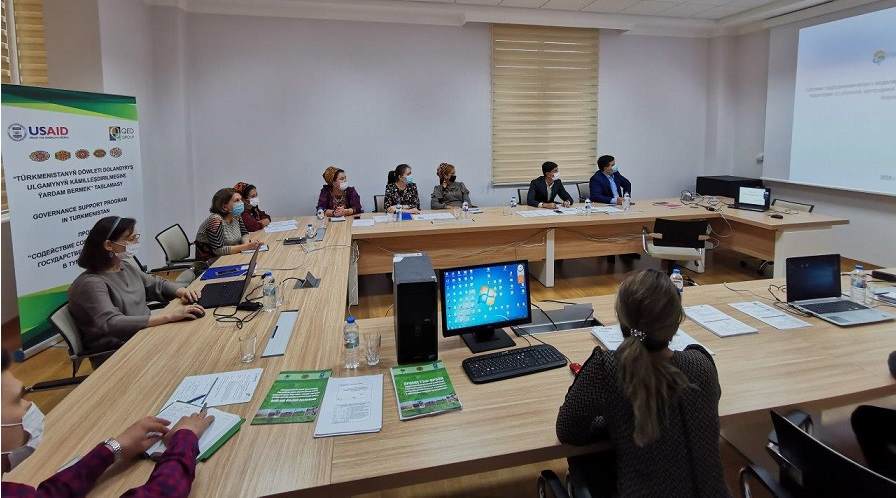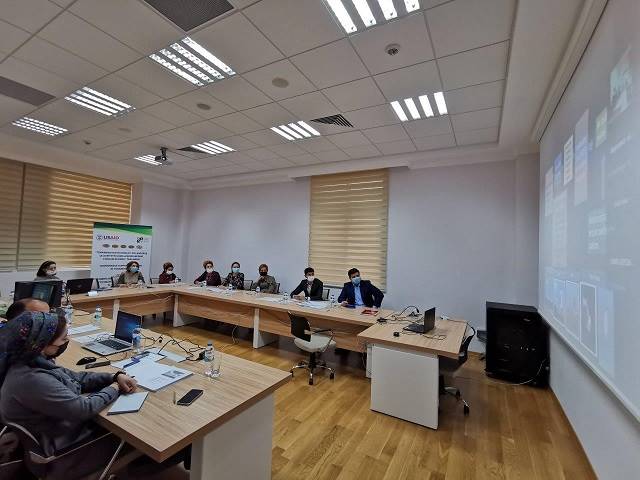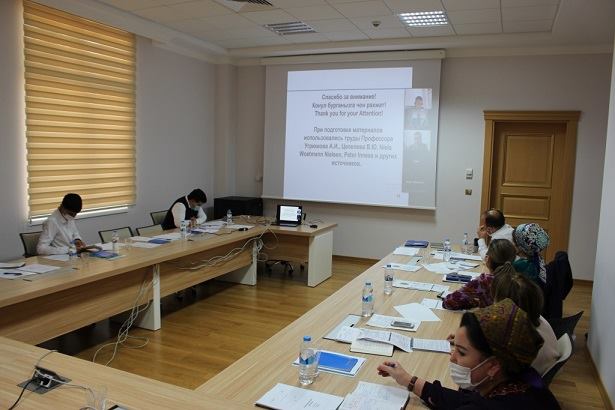One-week training course has been carried out this week in Ashgabat on the topic: Atmospheric circulation and synoptic processes in the territory of Turkmenistan and neighboring states for specialists of “Turkmenhydromet”, which operates in the system of The Ministry of Agriculture and Environmental Protection of Turkmenistan. Meteorology is a science that studies weather phenomena associated with the atmosphere.
Remote monitoring, satellite imagery, forecasting processes have been transferred nowadays to digital format, which are supported by many specialized computer-based software. The lexicon of forecasters includes such terms as – scripts-algorithms for mapping and visualization of weather realities, meteograms, binary files, task schedulers, etc. It should be stated that a specialist who studies and analyzes weather must have remarkable computer literacy, programming, the ability to use various modules and technologies, and combine them in his or her work.
Forecaster Engineer Ms. Alma Ataeva, Hydrological Engineer Ms. Maria Agalkhanova spoke about usefulness of such a scientific and practical exchange, the study of new practices, approaches and focus in enriching the process of understanding the conditions for the formation of weather situations, which helps specialists to get acquainted with new techniques. “The geographical positioning, contrasting landscaping, uneven landscape of Turkmenistan makes the territory of the country a place of formation of various weather conditions with their rapid fluctuation, where the influence on the processes in the atmosphere is increased by mountains, desert and the sea,” says Ms. Elena Bobriyskaya. In Kyrgyzstan, mountains compose a terrain similar to ours, and Kyrgyz colleagues have created their own developments to make forecasts in mountainous areas, where the weather is difficult to predict. Heavy precipitation and mudflows can be a single tandem of interconnected processes over a vast territory.
Her colleague Ms. Guncha Artykova noted that the Speaker from Kyrgyzstan has extensive professional experience, two higher education degrees in the field of meteorology. The material presented by him with specific examples was informative and interesting Trainees. He spoke about his work, described synoptic models used in Kyrgyzstan and other Central Asian countries.
The difficultly is predictable nature of the mountainous terrains created by landscapes, however, they can be viewed from different points of view by tracking the movement, speed of development of weather fronts, their “condition”, direction of movement. This work is supported by modern computer technologies – schemes that can be considered even in a 3D image and the possible consequences can be analyzed. The Expert stated that it is important and necessary to study the experience of neighboring countries, learn new methodologies, communicate with colleagues and the other participants of the meeting and all agreed with this and supported it as the next step action.
The Head of the Forecasting Department Mr. Dayanch Garabaev explained that the topic of the training was ordered by “Turkmenhydromet”, based on the scientific needs of organizations where 700 people work on the network, 55 specialists work in the Ashgabat Capital City Central Office, and 45 workers work at the Technical Center. In total, 27 people attended the Lecture Course, including hydrologists, forecasters, and IT specialists. The Beneficiary Organization “Turkmenhydromet” requested topics, which relate to the southwestern and southern cyclones and their impact on the territory of Turkmenistan and the International Expert of the USAID GSP prepared the Presentation based on those topics.
The Head of the International Department of the Institution, Ms. Bahara Sapargeldyeva, highly appreciated the quality of the presentation, the organization of the event, the work of Partners from the Governance Support Program in Turkmenistan (GSP) funded by the United States Agency for International Development (USAID) and UNDP/SCRL project.
The GSP Monitoring and Development Specialist Ms. Zuleyha Achilova emphasized the overall support of participants of the Training who requested to continue this Partnership even beyond the Training.







Comments